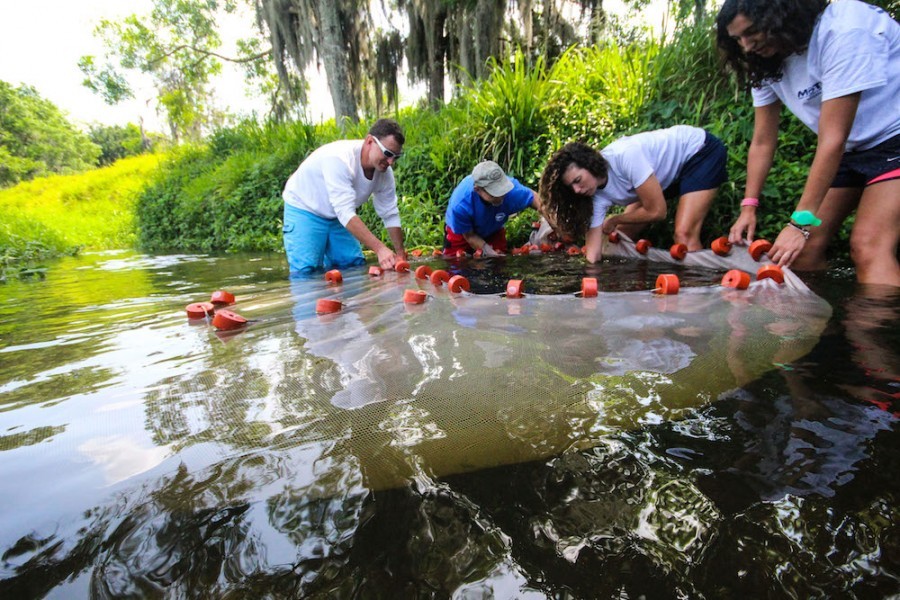Mote Marine Laboratory researchers are conducting the first scientific survey of fishes in human-made canals of Sarasota County. These canals were designed for flood control, and until now, no one had systematically studied how they might benefit native fisheries.
This month, April 2016, Mote researchers are using seine nets to catch and release fish throughout the county’s largest canal system, which drains into Phillippi Creek. They are documenting the species diversity and abundance of fishes, along with characteristics of their habitats.
Today, April 12, the researchers sampled the freshwater Main B canal near Bobby Jones Golf Club and found native fishes such as largemouth bass, spotted sunfish, least killifish, grass shrimp, mosquitofish and redear sunfish. They also found the nonnative Asiatic clam. Their recent samples in various county canals have turned up native species such as mullet, crayfish, mussels, gar, brook silversides and seminole killifish, along with nonnatives such as African jewelfish and
Tilapia species.
“These canals were constructed to protect an urban system from flooding, but they are also used by wildlife, and we need to know more about their value to fish,” said Dr. Jim Locascio, manager of the Fisheries Habitat Ecology Program at Mote. “Knowing what fish are there can help us understand how the canals relate to natural systems downstream.”
The project is funded by Sarasota Bay Estuary Program (SBEP), and it serves a broader Sarasota County initiative to understand how these flood-control canals might be better managed to improve water quality and conserve natural resources.
Many local residents are familiar with the county’s canals, which border backyards and thoroughfares and pass through popular parks and preserves such as Celery Fields and Red Bug Slough. Some people fish in the canals. In addition, fish-eating predators such as river otters dwell along them.
“How can we look at these as more than drainage canals?” said Dr. Jay Leverone, Staff Scientist at SBEP. “We hope this begins a continual effort to collect and provide information to Sarasota County’s stormwater staff to get full value out of these systems for the benefit of everyone.”
The current study focuses on canals draining into Phillippi Creek, an estuarine tidal creek system within the Sarasota Bay Watershed. Phillippi Creek drains an area of approximately 60 square miles (145 square kilometers). This and other tidal creeks provide important habitats for sport fishes such as snook.
“Sarasota County has invested in making Phillippi Creek healthier with septic-to-sewer replacement program and stormwater treatment and wetlands restoration at the Celery Fields,” said John Ryan, Environmental Manager for Sarasota County’s Stormwater Environmental Utility. “A lot of work has been done and more is needed.”
Mote, SBEP and others are gathering data and engaging community members in efforts to advance the science needed for management. The more scientists learn about the fish in these canal systems — and the Phillippi Creek watershed in general — the more they will understand how the canals influence natural systems downstream, and ultimately, Sarasota Bay. This knowledge will help inform science-based restoration and enhancement projects throughout the watershed.
Studying these interconnected waterways will help provide opportunities for ecosystem-based management — a relatively new way to support conservation and sustainable use of natural resources. Ecosystem-based management relies on science and emphasizes the connections among species, natural communities, habitats and human activity in a given place, to maintain the ecosystems that matter to communities.
“This is a great opportunity — ideally these canals could be enhanced to better filter nutrients and sediments, serve as productive nursery habitats for fishes and add to the county’s natural beauty,” said Dr. Nathan Brennan, staff scientist in Mote’s Fisheries Habitat Ecology Program. “Our current study is an early step forward, and we see great potential for future synergy among fisheries scientists, interested plant biologists and environmental engineers, along with community groups and students who care about the health of Phillippi Creek.”


